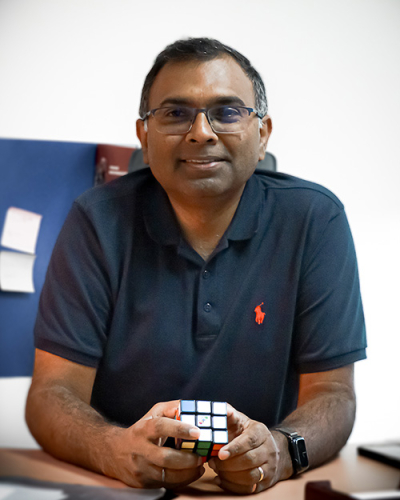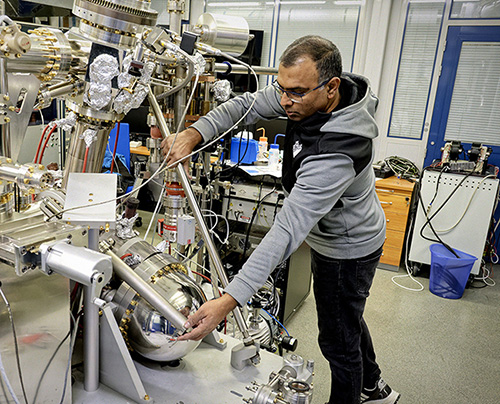In a series of portraits, SOLEIL meets the men and women behind the synchrotron. For this first episode, Sufal Swaraj, a researcher specializing in X-ray spectromicroscopy on the HERMES beamline, agreed to play along.
His job? Maintaining the beamline in working order, while adapting it to constant scientific developments. Sufal Swaraj is also working on the design of new carbon-based photovoltaic devices, less expensive and more versatile than currently popular solar cells.
Interview with an inquisitive man, passionate about experiments, whether scientific, musical, or literary.

“When I was a kid, my curiosity about how things worked often had interesting consequences: blowing up fuses several times a day, breaking my nose while pretending to make repairs on motorbikes, making strange concoctions…”
Originally from Ranchi, India, Sufal Swaraj has always enjoyed exploring, understanding, and experimenting from an early age... probably under the very patient eye of his parents.
Learning from enthusiasts
His fascination for the world around him, encouraged by his teachers, led him to pursue a Master's degree in Physics at the Indian Institute of Technology in Madras (IIT). “My teachers and university professors have influenced me a lot as they introduced me to a host of science books which were very philosophical as well as basic.” recalls Sufal. “I have been fortunate to learn from seniors and supervisors who were the best in their fields.” And when he was not in class, he devoted himself to the amateur creation of learning software on electromagnetic radiation.
Sufal went on to complete a doctorate in chemistry at Berlin's Free University, before taking up a post-doctorate in the same city at the Federal Institute for Materials Research and Testing (BAM), where for a year and a half he enthusiastically studied the fundamental properties of metals.
“Research is the only field in which a failed experiment provides as much knowledge as a successful one, for me it was only natural to get into research.” he explains.
In 2007, he crossed the Atlantic to join North Carolina State University and worked at the Advanced Light Source (ALS), the synchrotron at Lawrence Berkeley National Laboratory in California. During this second post-doctorate, Sufal began working in organic solar energy, which has since become his main field of research. For 3 years, he developed and explored various characterization techniques for organic and hybrid photovoltaic materials.
|
Photovoltaic panels: silicon VS organic Solar cells generate electricity when exposed to sunlight. Silicon-based solar cells, which currently dominate the market, have several limitations: they are expensive, bulky, etc. Organic (carbon-based) and hybrid (mix of organic/inorganic) solar cells could overcome these disadvantages of silicon cells. |
In 2010, the Synchrotron SOLEIL opens the HERMES beamline. An opportunity that Sufal seized without hesitation: "At the time, I was looking for positions that match my expertise, and I wanted to move to Europe. I was beginning to miss the continent after 3 years in the USA," he recalls. "Luckily, the position opened right when I was ready.” A few months later, the scientist joined the HERMES team and set about his new tasks: as a specialist in X-ray spectromicroscopy, he is responsible for keeping the beamline up and running and “up to date” with the current scientific environment.
New, more efficient solar cells
At the same time, Sufal is conducting research into the design of new carbon-based organic and hybrid photovoltaic devices, which are less expensive and more versatile than current solar cells, and more accessible to the public. "The materials I'm studying are very versatile and can be used in different forms, unlike today's very rigid solar panels," he points out. "Eventually, these materials could even be used as paint. For example, painting your house would mean making the entire house a solar cell. ", explains Sufal. But for the moment, these alternative materials are not yet as efficient as "classic" silicon-based solar cells, and their lifespan remains particularly limited. “Most of the research in this field -including mine- is based on making these materials overcome these limitations.” explains Sufal. “One of the ways is to mix organic materials with inorganic materials or nanoparticles.” he adds.

Sufal on the HERMES beamline
Making a contribution
"I am afraid we will not need to look at the news but just outside our window to find evidence of a planet rapidly becoming uninhabitable for humans.” he considers. “The record-breaking temperatures, persistent and widespread forest fires, floods in places that have never seen floods, icy winters, frequent storms and tornados…. These are only a few examples.” he continues. “This should be important to everyone.” But Sufal is optimistic. “World politics is waking up to the environmental crisis as well. Certain commitments at individual levels are also required. Science plays its role by providing solutions for a more environmentally reasonable lifestyle. I hope to make my contribution, however modest.”
“It will only take a walk around SOLEIL to witness experiments on meteorites, viruses, batteries, and plants…”
Curious about everything, Sufal doesn't hesitate to break away from his specialty to take an interest in his colleagues’ research: “You just have to walk around SOLEIL to witness experiments on meteorites, viruses, batteries, and plants… a wide variety of research and work is carried out here by scientists from all over the world” he explains. “I'm far from the only one working on environmental issues, and others have areas of expertise that cover equally important issues such as health, art conservation, agri-food, astronomy etc.” he adds. For Sufal, being part of the SOLEIL team is a "wonderful" experience, where the working environment is "conducive" to scientific reflection and development. " I feel very fortunate to be part of an impactful laboratory such as SOLEIL." he says.
Painting, music, soap sculpture and Rubik's Cube
The researcher has no regrets about moving to France, a "culturally rich country, a great place to raise a family", he justifies. "Kids are taught to be able to think critically from a very early age through the education system, and the work-life balance is great." A rhythm of life that allows Sufal to devote occasionally some time to artistic practice, one of his favorite activities. "I've been sketching and painting since I was a child... I wouldn't say I'm good at it, but it helps me relax," he says. For several years, the researcher was part of SOLEIL's arts section, where he learned a lot from his colleagues, "and for once, it wasn't science", he smiles.
Sufal is also a self-taught player of several musical instruments, including the flute, harmonica, and guitar, and practices woodworking, long-distance cycling and other less common activities such as soap sculpting and speed-cubing, which involves solving a Rubik's Cube as quickly as possible.
"In research, as in music, don't be afraid of wrong notes. One should be ready to encounter failures and learn to be patient”
These many passions came to Sufal naturally, through his tremendous appetite for trying out new things: "that's how you get the most enjoyment out of practicing, and how quickly you progress", he believes. The scientist also draws a parallel with materials science research: " A strong foundation in the sciences is a must, but to make a career as a scientist, one should have a natural disposition towards asking questions and figuring things out. ", he continues. "As in music, don't be afraid of wrong notes. You'll learn from your failures. One should be ready to encounter failures and learn to be patient." concludes the researcher.
Sufal Swaraj's mini biography
- 1978: born in Ranchi, India
- 1985-1998: blown fuses, broken nose, preparation of more or less conclusive concoctions
- 2001: master's degree in physics from the Indian Institute of Technology (IIT) in Madras, India
- 2005: PhD in Chemistry at the Free University of Berlin, Germany
- 2005 - 2007: postdoctorate at the Federal Institute for Materials Testing and Research (BAM)
- 2007 - 2010: postdoctorate at the University of North Carolina, based at the Advanced Light Source (ALS) at Lawrence-Berkeley National Laboratory in California, USA
- 2010 - present: scientist on the HERMES beamline, Synchrotron SOLEIL, Saint-Aubin, France
- 2022: Habilitation to direct research (HDR), Université Paris-Saclay, Gif-sur-Yvette, France
In Sufal's library
- Sapiens, a brief history of Humankind, Yuval Noah Harari
"This is the book I am reading right now. It’s a book written by a genius that everyone should read. The way the author presents the path of human civilization is both enlightening and shocking. Sapiens, a brief history of Humankind is a sobering reminder of our future, especially given the exponential trajectory of our technological developments. It's a book that can be read with mixed feelings, between appreciation and apprehension."
- A short history of nearly everything, Bill Bryson
"This is another book I really like. Although Bill Bryson is first and foremost a travel writer, this scientific work is an excellent read, even if you have no background in the field. I think it should be illegal not to have read it."
